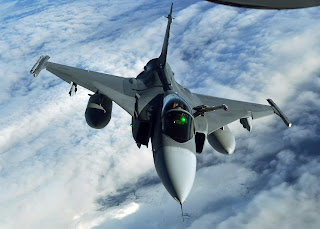Saab links Gripen bid with Tejas to counter F-16 production numbers as INDIA's 90 MMRCA deal fight Heats up
The contest to supply the Indian Air Force (IAF) a single-engine, medium fighter is currently playing out as a two-horse race. US giant, Lockheed Martin, is the Goliath looking to slay the David that is Swedish firm, Saab.
Lockheed Martin, which has offered to shift its F-16production line to India, is the world's biggest defence firm, with $46.1 billion in sales last year and an order backlog of almost $100 billion. Saab, which has offered its latest fighter, the Gripen E, appears a relative minnow, with $3 billion in sales last year, and an order book of $12.9 billion.
Lockheed Martin, which has offered to shift its F-16production line to India, is the world's biggest defence firm, with $46.1 billion in sales last year and an order backlog of almost $100 billion. Saab, which has offered its latest fighter, the Gripen E, appears a relative minnow, with $3 billion in sales last year, and an order book of $12.9 billion.
The museum displays the J-29 "Flying Barrel", the first "swept-wing" fighter after World War II; the Draken, Europe's first supersonic fighter, which pioneered the "double delta wing", and the Viggen, the first mainstream fighter to feature the canard - now common in high-performance fighters. India came close to buying the Viggen but Washington, which provided the engines, blocked the sale in 1978. The IAF bought the Anglo-French Jaguar instead, which still remains in service.
As Saab's marketing team never tires of telling Indians, this excellence in defence production stemmed from Sweden's traditional strategic independence - similar to India's. After remaining neutral through World War II, Sweden declined to join NATO in 1949, choosing to cater for its own defence against Russia.
Responsible for its own defence, Sweden leveraged an existing scientific and engineering culture to develop an advanced aerospace and defence industry. In the late 1950s, the Swedish Air Force was the world's fourth largest, fielding over 1,000 frontline aircraft.
Anticipating that a Soviet invasion would quickly render its airfields unusable, the Swedish Air Force insisted on light, versatile fighters that could operate from short stretches of highway, refuelling and rearming in minutes before re-joining battle.
This is the tradition that shapes the JAS-39 Gripen E, Saab's latest and most advanced fighter that is expected to make its first flight by end-2016. Unlike Dassault's Rafale, which endured tortuous years of wait before Egypt became its first export customer, the Gripen E has been selected by Brazil even before its first flight. In winning the Brazil tender, the Gripen E beat the Rafale, and Boeing's F/A-18E/F Super Hornet.
In sheer aerodynamic performance, the Gripen E will probably be a match for the F-16 Block 70. While the former has still to fly, its predecessor, the Gripen D, was extensively evaluated by theIAF - mainly to its satisfaction - as part of the 2007 medium multi-role combat aircraft (MMRCA) tender. The Gripen E, incorporating a new General Electric F-414 engine; is larger, heavier and more powerful than the Gripen D, which had an older F-404 power plant.
Even the avionics are comparable. The F-16's Northrop Grumman APG-83 airborne electronically scanned array (AESA) radar is a proven, highly effective combat system. But the Gripen E could score with more sophisticated data networks that bring together inputs from multiple sensors - such as airborne warning and control systems (AWACS), satellites and a fighter's own AESA radar - fusing data to present a comprehensive picture of the air battle in a cockpit arrangement that is amongst the world's most pilot-friendly.
With combat performance similar, the choice between the F-16 and Gripen E could boil down, asIAF boss, Air Chief Marshal Arup Raha said last month, to two factors - procurement and operating cost, and technology transfer.
In procurement cost, Lockheed Martin would score by transferring a fully amortised assembly line from Forth Worth, Texas to India. Further, by creating a vendor and sub-vendor eco-system in India to sustain a global inventory of 3,200 F-16s, spares and maintenance, repair and overhaul (MRO) would be cheaper.




Comments
Post a Comment